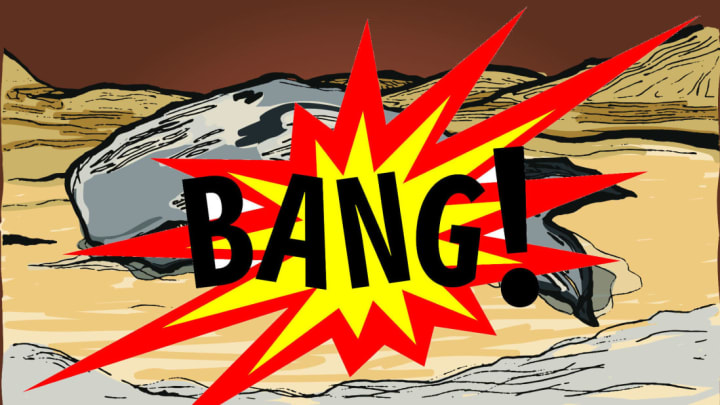The 75 or so people who had gathered on the shore just south of Florence, Oregon, on November 12, 1970 stood at a safe distance and waited for the dynamite to go off. The explosives had been buried under the landward side of a 45-foot-long, 8-ton sperm whale. The mammal would feel nothing when it exploded; it had washed ashore several days before and was long dead.
Its status as a non-living organism was, in fact, the source of the problem. The whale had begun to emit a putrefying stench that repulsed beachgoers. It simply could not remain in place. Its fate was left up to the Oregon State Highway Department, which had no experience relocating whale carcasses and decided to treat it as they would a massive boulder that needed to be removed.
The issue was that this was no boulder. It was a whale. And no one was sure exactly how much dynamite it would take to reduce it to bite-sized pieces of blubber that seagulls and other scavengers would eat. To be on the safe side, 20 cases—or approximately one half-ton—of explosives were used. What happened next is something Florence locals still talk about nearly 50 years later.
It’s not always clear why whales strand themselves on land. Sometimes, an injury or illness weakens them to the point they can no longer swim, so they simply wash ashore. Orca whales might chase prey and then find themselves in shallow water—and unable to get back to the open ocean.

However the whale near Florence found itself on the beach, it quickly began to make a posthumous impression. Visitors’ curiosity soon gave way to repulsion as the whale decomposed. Because the beach in Lane County was a public right of way, and nearby roads had a speed limit of 25 miles per hour to observe, the task of dealing with the whale was left up to George Thornton, the assistant district highway engineer of the Oregon State Highway Department, and his team.
It had been a while since a whale had washed ashore in the area, and no one knew exactly how best to deal with it—though various solutions were proposed. One idea was to simply bury the whale in the sand in an oceanside grave, but there were concerns the incoming tide might cause it to resurface. Another suggestion was to cut up the corpse, but there were no volunteers for what would amount to an incredibly unpleasant and time-consuming job hacking away at the blubber. Burning it was also impractical.
That left the seemingly rational option of blowing it up, which dead whales sometimes do naturally; the build-up of gases like ammonia, hydrogen, methane, and sulfide can result in a gory burst of guts spewing forth. But Thornton needed a more potent blast. He consulted with Navy munitions experts who theorized that, with an explosion, the whale would be reduced to chunks that would head toward the Pacific Ocean. Any lingering pieces could be retrieved by workers later.
Local news station KATU sent reporter Paul Linnman and photojournalist Doug Brazil to the scene via helicopter to cover the event. The two arrived and began filming a segment that included an interview with Thornton and a dispatch from Linnman with an enormous dead whale in the background.
At 3:30 p.m., spectators and the reporters were asked to move back roughly a quarter-mile away. At 3:45 p.m., Thornton ordered the explosives to be detonated. The scene was captured by the KATU team.
At first, locals cheered the spectacle, which resembled a building demolition. But cheers soon gave way to panic as it became apparent that the half-ton of dynamite had been insufficient to atomize the whale. Large chunks of blubber sailed over their heads and landed with a thud at their feet. Smaller pieces pelted their bodies. The smell of putrid whale oil engulfed the scene. In a spectacular denouement, a giant piece of whale at least 3 square feet in size landed directly on a brand-new Cadillac, smashing the top and blowing out the windows. The vehicle's owner, Walter F. Umenhofer, had wanted to meet a business partner at the detonation ceremony.
Incredibly, no one was injured. But as locals beat a retreat, it became obvious that further action would have to be taken. A large portion of the whale remained; it was eventually moved using a bulldozer and buried on the beach. Smaller bits of blubber were collected and either discarded or covered in sand. Seagulls that had been expected to feast on the remains were scared off by the explosion and remained wary of the area for some time.
For years, Thornton refused to discuss the incident, slightly bashful about the consequences of attempting to blow up a whale. Later, when the footage was circulated online, some people thought it was a hoax. Today, locals celebrate the anniversary by dressing as various whale parts and then running around that very same beach. Just this month, Florence unveiled a new park to commemorate the 50th anniversary of the incident: Exploding Whale Memorial Park.
When 41 sperm whales beached themselves near the same area in 1979, no dynamite was used; they were instead buried in the sand. As for the Cadillac: The state of Oregon reimbursed Umenhofer for the car. His son, Kelly, who was 14 at the time and went with his father to the beach, would later recall that the car had been bought at Old’s Dunham Cadillac, a dealership that promised buyers—prophetically, it turns out—that they would get “a whale of a deal.”
